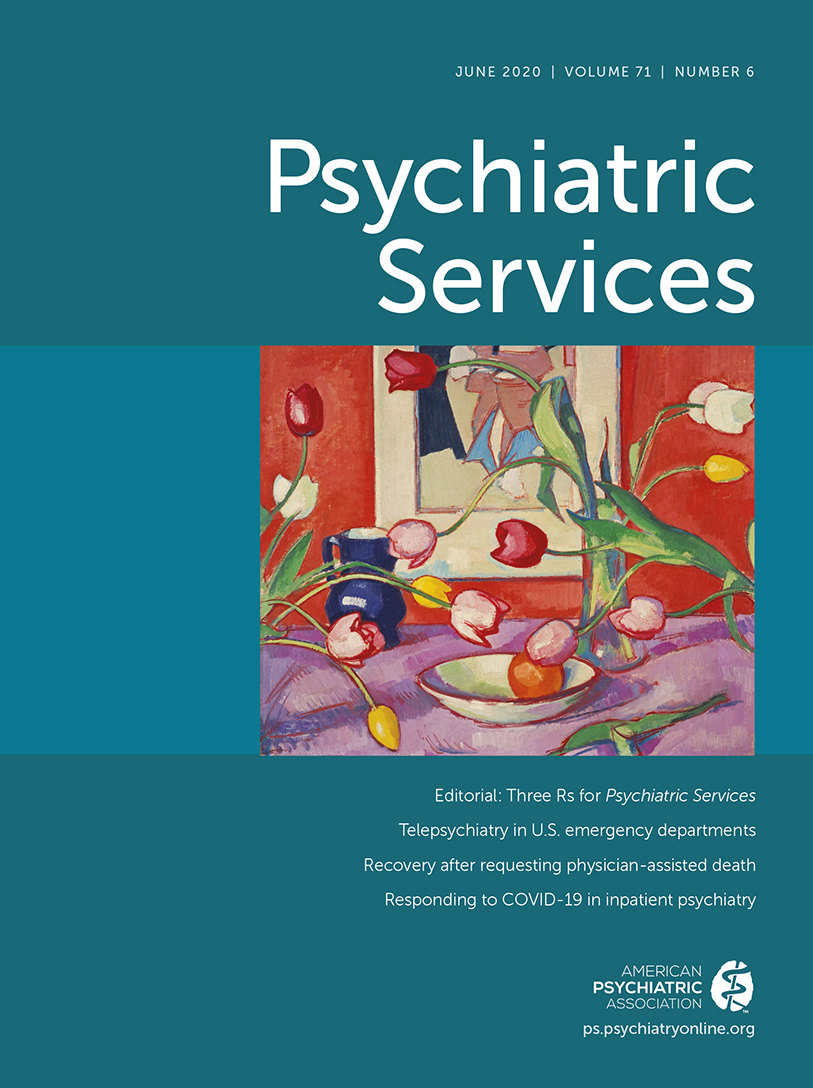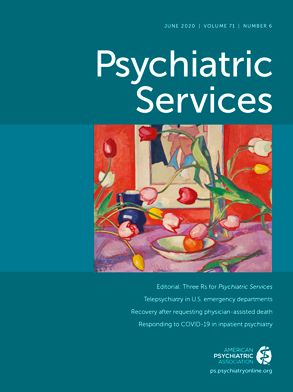This Open Forum explores contingency planning for responding to COVID-19 in inpatient psychiatric facilities, with a focus on clinical operations and delivery of services. COVID-19 is a novel coronavirus with symptoms of respiratory distress and fever that can then progress to death, with a mortality rate of approximately 1%−2% (
1,
2). COVID-19 was deemed a pandemic by the World Health Organization (
3). In the United States, COVID-19 has spread to all states, with increasing detection of cases as testing becomes more widely available. The condition is airborne and transfers through respiratory droplets. The Centers for Disease Control and Prevention published recommendations for minimizing COVID-19 spread in health care settings, making recommendations on mitigation steps to reduce community transmission of COVID-19, such as restricting visitors, adjusting standards of care, changing elective procedures, and establishing cohort units, among others (
4).
Unique Challenges of Inpatient Psychiatric Settings
Inpatient psychiatric settings present unique challenges because of open-space units, patient population, and close contact for treatment. In many psychiatric units, patients are free to move about and interact with other patients. It can be difficult to isolate patients who have behavioral dysregulation from symptoms of active mania and psychosis. In addition, staff are in close contact with patients, with regulatory requirements to do visual checks on patients every 15 minutes and perform safety checks. Patients and clinical staff have therapeutic interactions multiple times per day for rounding and examinations. In addition, basic structural challenges exist for infection prevention in psychiatric facilities. For example, many psychiatric facilities have shared bathrooms and can provide only non–alcohol-based hand sanitizer for safety precautions. Handwashing per recommendations can be a difficult task, because some psychiatric patients have poor hygiene and limited ability to comprehend directions as a result of their psychiatric illness. Psychiatric patients are admitted to a hospital for safety concerns, and thus they cannot be discharged home to self-quarantine if symptoms of COVID-19 infection develop (
5).
In addition to the direct challenges in physical space and exposure risks to staff and patients, indirect challenges can affect service delivery in inpatient psychiatric settings during a pandemic. Multiple public and clinical services are closing or may close in order to limit close social contact, including shelters, schools, social services, psychiatry offices, and probate court. These factors can all contribute to difficulty discharging patients, which can result in more patients boarding in the emergency room as they wait for beds to become available. Several states and the federal government have declared a state of emergency due to COVID-19, and routine services have been limited, refocused, or closed. Closure of the probate court would delay the commitment process for involuntary hospitalization, involuntary medication administration, and electroconvulsive therapy. Thus psychiatric illness may be undertreated for a longer period, exacerbating the duration of acute illness for some individuals. Similarly, lack of social services infrastructure can create negative downstream impacts in helping patients obtain housing and schedule follow-up visits, and patients may be unable to obtain the next level of care when services are shut down.
The stressor of a pandemic may worsen psychiatric symptoms for individuals—for example, those with psychosomatic delusions may experience more intense paranoia. With increasing numbers of individuals seeking care, it is important to strategically plan and advocate for services and resources to support high-quality, safe psychiatric care delivery. Otherwise, psychiatric patients will be vulnerable not only because of their mental illness but also because of the repercussions of COVID-19. Contingency planning for psychiatric inpatient services requires careful decision making and prioritization of efforts, given limitations in time and resources.
Nuanced Considerations in Contingency Planning
Managing COVID-19: specific precautions.
For inpatient psychiatry, an important consideration is to screen patients diligently for respiratory symptoms and fever prior to admission. Although psychiatric facilities vary in whether they are a free-standing facility or an inpatient psychiatric unit attached to a medical center, all facilities should consider screening patients for COVID-19 symptoms prior to admission, as well as rescreening for symptoms throughout the hospitalization, because asymptomatic patients may develop COVID-19 after psychiatric admission.
Personal protective equipment should be used in cases where patients develop fever and respiratory symptoms, although its use should be minimized if patients do not meet both criteria, especially if personal protective equipment supplies are low. Clinical leadership should also consider having staff wear designated clothing, such as scrubs, during the workday to minimize transfer of the coronavirus on various surfaces. In addition, surfaces should be cleaned often, using recommended cleaning agents, such as high-content ethanol-based hand sanitizer for disinfecting oneself and surfaces (
6). In addition, disinfection should be performed on items and spaces used frequently, including dining areas, doorways, common-use computers, and identification cards, which contain plastic and metal and can transmit COVID-19 (
7).
Restricting visitors and minimizing nonessential contacts .
To minimize risk for direct contact by outsiders exposed to COVID-19, visitor restrictions for family members, nonessential employees, and students can be an important decision point in order to protect essential staff and patients from exposure to additional outside individuals. However, social interactions and family meetings are important components of inpatient treatment. Thus, although decisions may be made to limit contact, doing so may affect the treatment course and how patients reconnect with family members and may cause significant anxiety among family members who are apart from loved ones. Similarly, limiting students from observing clinical processes may affect graduation requirements for those students.
Physician workforce considerations.
Even with no pandemic, there is a national shortage of psychiatric providers (
8). During the pandemic, the provider shortage will worsen as psychiatrists are exposed and become ill. Administrators and clinical leaders will need to identify strategies to address the shortage, including creation of back-up systems to include psychiatrists and providers who are credentialed at the facility, and they may need to find creative ways to increase staffing. Potential options for staffing include reducing team sizes and creating a back-up pool of providers who can truly practice physical distancing and become available if designated frontline providers become unable to provide care. Also, providers working in research and nonclinical administrative roles can be reassigned to clinical care as part of a back-up pool. In addition, telepsychiatry can be an important consideration for delivering inpatient services to minimize simultaneous exposure of a high number of clinical providers (
9). Thus staff can still perform clinical care while minimizing their exposure to the hospital. Staff should self-monitor for symptom development and obtain testing if symptoms such as fever or respiratory symptoms are present. In addition, staff with higher risk, including pregnant, elderly, and immunocompromised individuals, may need to be sent home to work remotely during the pandemic period.
Operational adjustments .
Limited published accounts are available on operational changes in response to COVID-19, especially in psychiatry. COVID-19 has an asymptomatic period, and thus some individuals may not have COVID-19 symptoms before being admitted (
10). Designated isolation rooms may be helpful in grouping patients with COVID-19 symptoms, which may require closing one or more hospital beds if two or more patients are roomed together. After a patient develops COVID-19 symptoms, the patient should be immediately placed on precautions that require wearing a mask and gown and being isolated in designated rooms to minimize spread. If a psychiatric facility is connected to a medical center, steps should be taken to facilitate transfer to inpatient medicine or inpatient pediatrics for COVID-19 testing, because many psychiatric facilities have open milieu and would have difficulty isolating patients to avoid significant spread. Patients with subthreshold symptoms, such as only fever or only respiratory symptoms, should be monitored more closely for development of additional symptoms, including more frequent monitoring of vital signs and review of symptoms. Other medical conditions, such as viral influenza and routine causes of fever or respiratory symptoms, should be explored. Patients who develop COVID-19 symptoms should be monitored closely for imminent risk of suicide, homicide, and grave disability. If the patient is considered psychiatrically stable, he or she should be discharged to outpatient care and self-quarantine. Additional considerations should be made regarding the threshold for hospitalization. Psychiatric hospitalizations that are not absolutely necessary for acute safety concerns should be minimized.
Group therapy changes .
Group therapy is an important component of inpatient treatment as part of the ecological milieu (
11–
13). Multiple individuals meet together with a trained facilitator to learn about psychological tools to address symptoms such as anxiety, depression, suicidal ideation, psychosis, and intense emotional lability and to facilitate education about psychiatric conditions. Such meetings reinforce treatment goals and provide positive supports. However, given that group therapy requires close contact, decisions to facilitate changes in group treatment may be needed, including limiting the number of individuals participating in a group and ensuring that physical distancing among individuals occurs. In addition, older patients with multiple medical comorbidities may be especially at risk in group settings with younger patients and may need to discontinue and minimize group therapy during a pandemic. However, limiting group treatment options and reducing group size may lead to social isolation and loneliness—factors that may have partly contributed to an individual’s hospitalization.
Leadership and Clear Communication
Responding to COVID-19 requires organized leadership and clear communication. These concepts are part of a framework for “high-reliability organizations,” which aim to improve clinical care through accountability and continuous learning and can minimize uncertainty, confusion, and human error due to knowledge gaps (
14). A core leadership task force can be developed to address immediate operational concerns. The task force should include representation by clinical leaders in psychiatry, social work, and nursing, at minimum. The aim of a small core group would be to initiate and coordinate ongoing response efforts and to minimize sharing of misinformation. Given the rate of new updates, the group would benefit from meeting several times a day to discuss information, implement decisions, and address clinical challenges. In addition, a strategy for communication should be developed to send out daily updates. Communicating clearly helps to address the many human resources challenges and clinical care changes in effect at the state or local level in response to COVID-19. Furthermore, additional smaller workgroups can be created to work on staffing, COVID-19 precautions, operational issues, and other important contingency planning efforts.
Conclusions
This Open Forum seeks to describe the nuanced considerations in responding to COVID-19 in inpatient psychiatry facilities and to provide conceptual and operational suggestions regarding early priorities to prepare for COVID-19. Clinical experts and medical leaders are closely monitoring the COVID-19 pandemic and implementing changes rapidly to respond to the crisis. Future opportunities will include learning from and reflecting about the decisions made and the responses adopted and studying them for efficacy and their impact on patients.
Acknowledgments
The author thanks Frank Fortunati, Rebecca Stanley, Todd Barnes, and other team members at the Yale New Haven Psychiatric Hospital for working on COVID-19 contingency management strategies that have informed this Open Forum.

